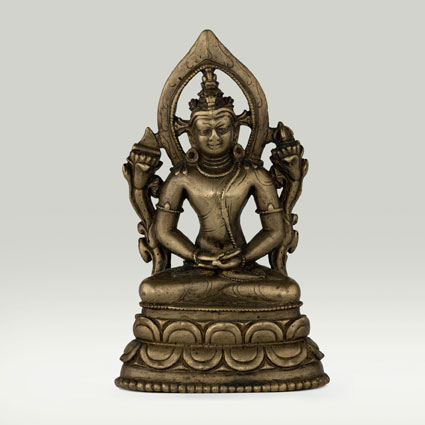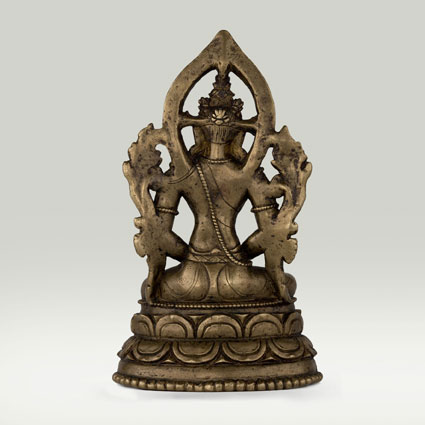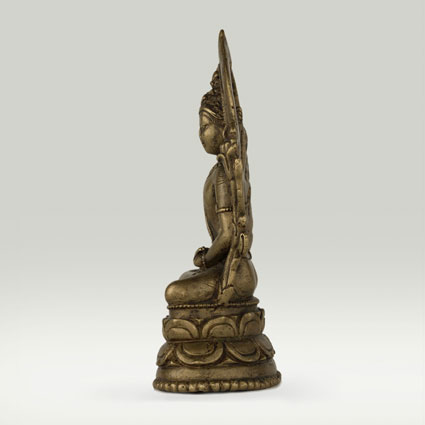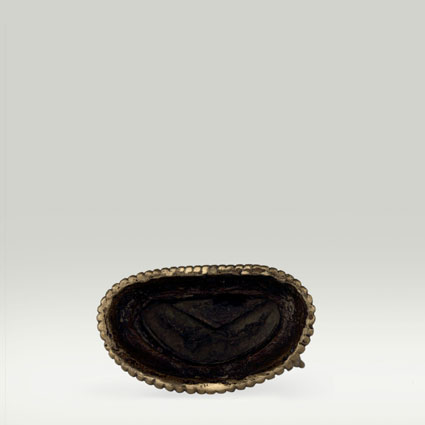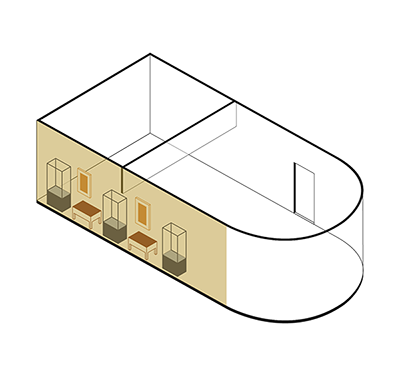ABS 053
Code: ABS 053
Country: Tibet (central)
Style: Late Pala Style
Date: 1150 - 1250
Dimensions in cm WxHxD: 7 x 11.6 x 4.2
Materials: Brass
The garments and jewelled ornaments are decorated with engraved ornaments.
The bottom of the pedestal is not sealed.
The male deity is seated in the diamond attitude (vajraparyankasana) on a double lotus pedestal and displays the gesture of meditation (samadhi-mudra). The two flowers at the shoulder level, which according to the sadhanas of Manjusri should represent the blue lily (nilotpala), are decorated on the left side the manuscript (pustaka) of the Astasahasrika Prajnaparamita Sutra and on the right side with half of a diamond sceptre (vajra).
At least three different two-armed deities displaying the gesture of meditation (samadhi or dhyana mudra) have to be distinguished, with two of them described in the Sadhanamala (SM): Amitabha (red) (SM 66, 68), with the characteristics of a crowned Buddha; Dharmasankha - samadhi Manjusri (white) (SM 64, 81), with characteristics of a Bodhisattva, often distinguished by a particularly shaped necklace; Vairocanabhisambodhi (Tib. rNam par snang mdzad mngon par byang chub) (white), with the characteristics of a crowned or uncrowned Buddha, the chief deity of the Karunagarbha Mandala of the Vairocanabhisambodhi (?) and the Vajradhatu Mandala of the Sarvatathagatatattvasamgraha Sutra (?). The identification of this image as Dharmasankha-samadhi Manjusri is based on the manuscript (pustaka), a distinct emblem of Manjusri. It should also be pointed out that the crowned forms of Amitabha (Tib. ’Od dpag med) usually do not carry a shawl over the left shoulder and tied around the chest.
(From Wikipedia, the free encyclopedia)
Manjushree, also written Manjushri, is the bodhisattva of keen awareness in Buddhism. A disciple of the historical Buddha Shakyamuni, he represents wisdom, intelligence and realisation, and is one of the most popular Bodhisattvas following Avalokitesvara (Ch: Guan Yin).
Together with Shakyamuni and fellow disciple Samantabhadra he forms the Shakyamuni trinity (Jp: Sanzon Shaka). Manjusri is one of the Eight Wisdom Bodhisattvas and one of the Japanese Thirteen Buddhas. In Tibetan Buddhism he sometimes is depicted in a trinity with Avalokiteshvara and Vajrapani.
Manjusri is mentioned in many Mahayana sutras, particularly the Prajnaparamita Sutras. The Lotus Sutra assigns him a paradise called Vimala, which according to the Avatamsaka Sutra is located in the east. His consort in some traditions is Saraswati. He is also sometimes called Manjughosha.
Within Tibetan Buddhism, Manjushri is a tantric meditational deity or Yidam, and considered a fully enlightened Buddha.
Manjusri Mantra
Chanting the Manjusri Mantra "Om Ah Ra Pa Tsa Na Dhih" is believed to enhance wisdom and improve one's skills in debating, memory, writing, explaining etc. "Dhih" is the seed syllable of the mantra and is chanted with greater emphasis.
A male Bodhisattva, he is depicted wielding a flaming sword in his right hand, representing his realisation of wisdom which cuts through ignorance and wrong views. The scripture supported by the flower held in his left hand is the Prajnaparamita, representing his attainment of ultimate realisation and Enlightenment. Variations upon his traditional form as Manjusri include Guhya-Manjusri, Guhya-Manjuvajra, and Manjuswari, most of which are Tantric forms associated with Tibetan Buddhism. The two former appearances are generally accompanied by a shakti deity embracing the main figure, symbolising union of form and spirit, matter and energy.
Manchu
According to legend Nurhaci, a military leader of the Jurchen tribes and founder of what became the Chinese imperial Qing Dynasty, believed himself to be a reincarnation of Manjusri. He therefore is said to have renamed his tribe the Manchu.
Yamantaka
Yamantaka (meaning “terminator of Yama i.e. Death”) is seen as a wrathful manifestation of Manjushri, the buddha of wisdom. Yamāntaka (Tibetan: Shinjeshe Wylie: Gshin-rje-gshed) is a Mahayana Buddhist yidam or iṣṭadevata of the Highest Yoga Tantra class in Vajrayana, popular within the Geluk school of Tibetan Buddhism.
Role in Nepalese Mythology
According to Swayambhu Purana, the Kathmandu Valley was once a lake. It is believed that Manjushri saw a lotus flower in the center of the lake and cut a gorge at Chovar to allow the lake to drain. The place where the lotus flower settled became Swayambhunath Stupa and the valley thus became habitable.
The Newars of the Kathmandu Valley, who adhere to both Buddhism and Hinduism, revere him as the Bodhisattva of Wisdom.
Chandra, Lokesh, 1986. Buddhist Iconography of Tibet (CBIT). Rinsen Book Co.. P. 712: The Three Hundred Icons (sKu brnyan sum brgya) [2206–2503], No. 2286 (83): Abhisaµbodhi-Vairocana (Tib. rNam snang mngon byang) - References to the iconography of two-armed deities in samadhi mudra
de Mallmann, Marie-Thérèse, 1964. Étude iconographique sur Manjusri. Paris: École Française d’Extrème-Orient. Pp. 36-42, pl. VI: Dharmasankha-samadhi Manjusri - References to the iconography of two-armed deities in samadhi mudra
de Mallmann, Marie-Thérèse, 1975. Introduction à l'iconographie du tântrisme bouddhique. Paris: Adrien Mainsonneuve (Jean Maisonneuve successeur (1970). Pp. 94–96: Amitabha - References to the iconography of two-armed deities in samadhi mudra
Gordon, Antoinette K. , 1959. The Iconography of Tibetan Lamaism. Vermont: Charles E. Tutle, 2nd revised and enlarged edition. P. 68, illus. facing p. 66: Dharmasankha-samadhimanjusri - References to the iconography of two-armed deities in samadhi mudra
Lo Bue, Erberto and Ricca, Franco, 1990. Gyantse Revisited. Firenze: Casa Editrice Le Lettere & Torino: Cesmeo. P. 144 - References to the iconography of two-armed deities in samadhi mudra
Tucci, Giuseppe, 1941. Indo-Tibetica, Vol. IV, Gyantse ed i suoi Monasteri, Parte I. Roma: Reale Accademia d’Italia. P. 119 - References to the iconography of two-armed deities in samadhi mudra

